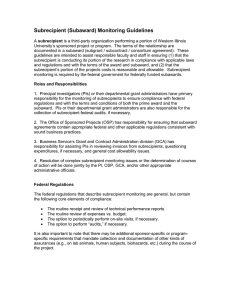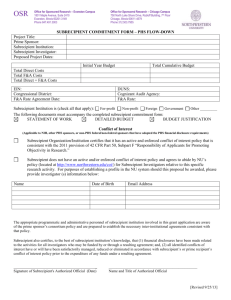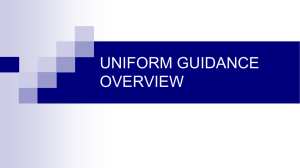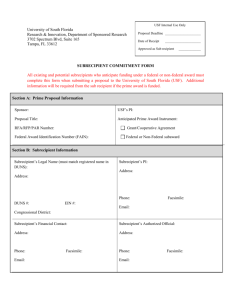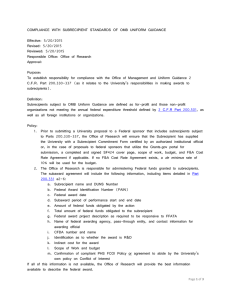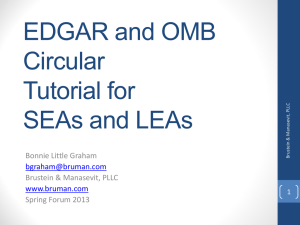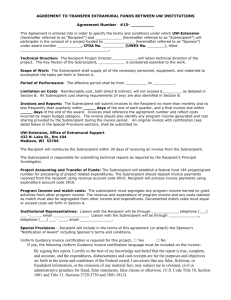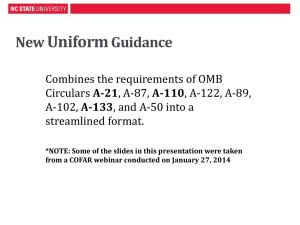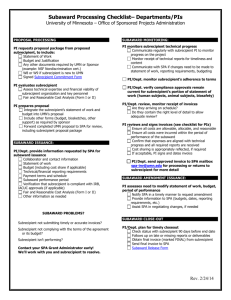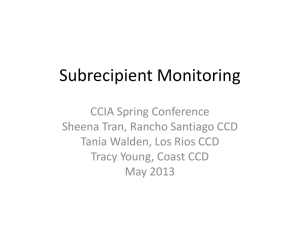Subrecipient Monitoring and Common Findings By USDE
advertisement
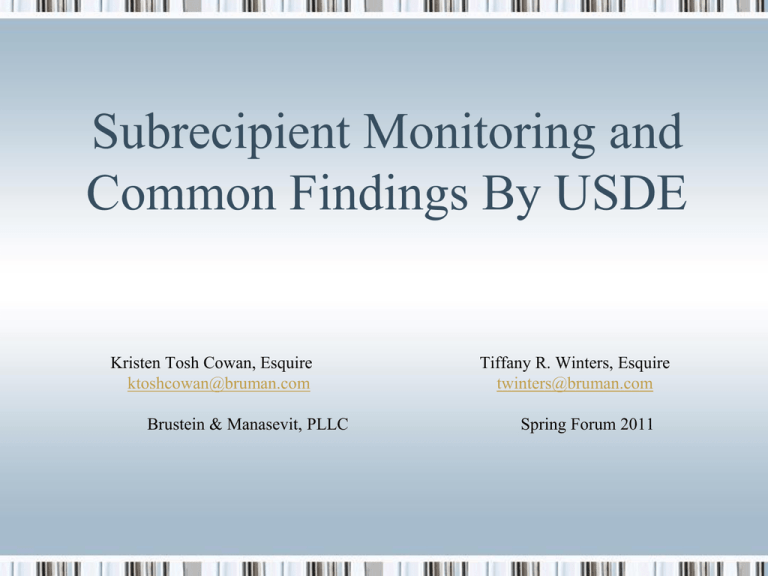
Subrecipient Monitoring and Common Findings By USDE Kristen Tosh Cowan, Esquire ktoshcowan@bruman.com Brustein & Manasevit, PLLC Tiffany R. Winters, Esquire twinters@bruman.com Spring Forum 2011 Checklist of Grantee Responsibilities Identify and provide information about federal awards Inform subrecipients about compliance requirements Monitor subrecipient activities Ensure subrecipients have single audits, if required Provide technical advice and training Issue management decisions within six months on subrecipient single audit findings and ensure corrective action occurs Consider whether pass-through entity records must be adjusted as a result of subrecipient audits Require subrecipients to permit its auditors access to their records for monitoring and audit purposes 2 Checklist of Subrecipient Responsibilities Administer the grant from award to closeout Develop internal policies and system to ensure effective management of federal funds and compliance Ensure organization has compliant grants management systems Establish a budget of costs required to perform the program and method for monitoring budget against actual expenditures Keep updated on policy/legal changes Request prior approvals when necessary Prepare all required reports in a timely manner 3 Model System: • AGA Partnership for Intergovernmental Management and Accountability • Financial and Administrative Monitoring Tool • Risk Assessment Monitoring Tool • http://agacgfm.org/intergovernmental/ resources.aspx 4 WHO and HOW OFTEN to monitor? • Do Risk Assessment – Where is state’s greatest risk of noncompliance? • AGA “Risk Assessment Monitoring Tool” 5 Methods for Monitoring • • • • • • • Review (NOT Solely Rely) Single Audits Arrange for Limited Scope Audits Schedule Site Visits Review Subrecipient Reports Require Prior Approval for Certain Activities Require 3rd Party Evaluators Follow Subrecipient Coverage in the News 6 When are On-site Visits Appropriate? Programs with complex compliance requirements High dollar programs New programs Prior monitoring or audit findings High profile programs Inexperienced subrecipients/staff Request onsite visit Sites not visited recently Risk Factors 7 Risk Factors: • General • • • • • Entity new to operating federal funds New program for entity High staff turnover or reorganization Experience of staff Untimely submission of applications, fiscal reporting, drawdowns, etc. • Have other entities alerted SEA of potential risks? 8 Risk Factors • Legal • Any lawsuits • Suspended or debarred • Staff jailed, convictions, criminal investigations 9 Risk Factors • Monitoring/Audits • • • • When was last on-site monitoring visit Any findings in prior visit More than one year since Single Audit Any special conditions put on awards 10 Risk Factors • Fiscal Assessment • • • • • • • Size of the grant Frequent untimely drawdowns Significant carryover Return of (lapsed) unspent funds Difficulty with matching/Maintenance of Effort (MOE) in past Cash flow problems Time and effort records for all employees paid with federal funds 11 WHAT to monitor? • Program requirements – NOT ENOUGH • Single Audits – NOT ENOUGH • AGA “Financial and Administrative Monitoring Tool” 12 AGA Tool • Administration • • • • • Internal controls Accounting Cash management Audit resolution Record Retention and Access 13 AGA Tool • Program (specific to program) • Eligible beneficiaries • Adequate plans • Allowable costs • Program Fiscal (specific to program) • • • • Budget Formation and Administration Matching/supplanting/MOE Comparability Set asides 14 AGA Tool • Cross-Cutting/Fiscal • • • • Payroll/Time Distribution Procurement Indirect Costs Property Management 15 Document! • Have written procedures explaining monitoring process and substance 16 Monitoring Follow-Up • Grantees should use monitoring results to identify: • Recurring problems unique to one program • Opportunities to better monitor funds • Recurring problems with individual subrecipients 17 Monitoring Follow-Up • Subrecipients should use monitoring results to identify: • Recurring problems that affect several programs that need to be corrected • Effective methods to administer subawards and comply with program requirements that can be applied to other subawards • Program-specific problems that may require a change 18 Office of Inspector General FY 2011 Work Plan Management Challenge: Implementation of New Programs/Statutory Changes •Recipient and Subrecipient Use of Recovery Act Funds to Meet Program Objectives • Oversight of SFSF •Centers for Independent Living Controls over Recovery Act Funds* •Race To The Top Grant Monitoring Process •Guaranty Agency Health •Discretionary Grant Monitoring Process for i3 Funds •Job Retention at Loan Servicers 19 Office of Inspector General FY2011 Work Plan Management Challenge: Oversight and Monitoring • FSA Oversight of Schools Participating in Direct Loan Program •Proprietary Schools’ Participation in SFA Programs •Approval of Proprietary School Change of Ownership •TEACH Grants Program •ECASLA Servicer Compliance* •ECASLA Custodian Billings and Financial Transactions* •Distance Education Programs Requirements and Monitoring •State Award and Monitoring of SIG •State Monitoring of IDEA, Part B MOE •Effectiveness of the Competitive Award Process for ESEA Programs •Potentially Overlapping High School Programs •Discretionary Grant Results •Oversight of Charter Schools 20 Office of Inspector General FY2011 Work Plan Management Challenge: Oversight and Monitoring, cont. • 21st Century CLC Process to Identify and Monitor High Risk/At Risk Grantees* •Federal Real Property Assistance Program •Title IV Additional Servicers Contracts •Suspension and Debarment Functions for Grantees • Management of the EDUCATE Contract •Audit Resolution Process* 21 Office of Inspector General FY2011 Work Plan Management Challenge: Data Quality and Reporting •Use and Accuracy of Performance Data Collected and Reported in EDFacts •Department Data Quality Processes for Recovery Act Recipient Reporting •Department Performance and Accountability Planning and Reporting Process 22 Office of Inspector General FY2011 Work Plan Management Challenge: Information Technology Security •System Security Controls over Education Department Centralized Automated Processing System •System Security Controls Over EDUCATE •Security Controls Over External FSA Data Centers 23 This presentation is intended solely to provide general information and does not constitute legal advice or a legal service. This presentation does not create a client-lawyer relationship with Brustein & Manasevit, PLLC and, therefore, carries none of the protections under the D.C. Rules of Professional Conduct. Attendance at this presentation, a later review of any printed or electronic materials, or any follow-up questions or communications arising out of this presentation with any attorney at Brustein & Manasevit, PLLC does not create an attorney-client relationship with Brustein & Manasevit, PLLC. You should not take any action based upon any information in this presentation without first consulting legal counsel familiar with your particular circumstances. 24
